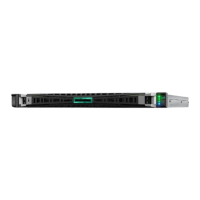IMPORTANT: To verify that you can improve performance in your environment, perform application
bench marking before you disable a processor prefetcher option.
Procedure
1. From the System Utilities screen, select System Configuration > BIOS/Platform Configuration
(RBSU) > Power and Performance Options > Processor Prefetcher Options.
2. Select a setting.
• HW Prefetcher
• Adjacent Sector Prefetcher
• DCU Stream Prefetcher
• DCU IP Prefetcher
• XPT Prefetcher
NOTE: This setting must be enabled when Sub-NUMA Clustering is enabled.
• LLC Prefetch
3. Select Disabled.
4. Save your changes.
Enabling or disabling I/O Options
Procedure
1. From the System Utilities screen, select System Configuration > BIOS/Platform Configuration
(RBSU) > Power and Performance Options > I/O Options.
2. Select an option.
• ACPI SLIT—Enables or disables the Advanced Configuration and Power Interface System Locality
Information Table (ACPI SLIT). ACPI SLIT defines the relative access times between processors,
memory subsystems, and I/O subsystems. Operating systems that support the SLIT can use this
information to improve performance by allocating resources and workloads more efficiently.
• Intel NIC DMA Channels (IOAT)—Enables or disables DMA acceleration on Intel NICs. If your
server does not have Intel NICs, leave this setting disabled.
• Memory Proximity Reporting for I/O—Enables or disables whether the system ROM reports the
proximity relationship between I/O devices and system memory to the operating system. Most
operating systems can use this information to efficiently assign memory resources for devices,
such as network controllers and storage devices.
NOTE: Certain I/O devices might not be able to take advantage of I/O handling benefits if their OS
drivers are not properly optimized to support this feature. For more information, see your operating
system and I/O device documentation.
Enabling or disabling I/O Options 97

